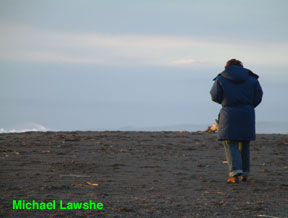Not all birds on the ground unable to fly are babies. Spring is definitely a time when people find and try to rescue baby birds, but just because a bird is small and grounded doesn't mean it is a fledgling.
This bird was found on the ground and her inability to fly made people think she was a lost baby bird.
But this is actually an adult female white-throated swift (Aeronautes saxatalis). As their Latin name suggests most of their life is spent in the air. They catch insects in flight, drink by scooping up a mouthful of water as they swoop over a pond, and even mate in the air. Some sources cite them as the fastest flying North American bird because they have been documented out flying their predator the peregrine falcon. White-throated swifts are considered the most aerial land-based bird; they land only to nest on vertical cliff faces and sometimes freeway overpasses (man-made cliffs).
Because they are an aerial bird, swift legs are tiny with feet for gripping vertical surfaces. On the ground a swift is out of its element, it can't really walk around. This female was found in an atrium at the hospital where my neighbor works. The hospital staff gave her water in a cup and bits of cracker. Unfortunately, both were completely foreign to this bird.
Why was she on the ground? We don't know for sure. There was no sign of a predator attack. but she most likely struck a window on the multistory hospital and then fell into the atrium surrounded by high walls. Fortunately, she did not break a wing or come to serious bodily harm.
When the neighbor first handed her to me in a box, my first thought was a violet-green swallow that had fallen from a nest. But once I had her in a quiet place and could evaluate her closely, I realized the amazing creature climbing up my hand was a bird I had only seen flying high overhead–a white-throated swift. Their long pointed wings slice through the air and the white belly and white flank spot make them easily identifiable from below. Most references only depict their appearance in flight because no one is going to see them on the ground. Yet, here she was.
With a little water offered from a dropper, she drank and rehydrated. She has a short stubby beak, but her mouth opening is large. She also has a pouch in her throat for carrying insects back to nestlings.
With her gripping claws she climbed up this brick wall and she spent the night sleeping while clinging to a vertical surface, much like a bat. (Insectivorous bats and swifts have similar lifestyles; one fills the ecological niche during the night and the other during the day.)
Injured wild birds frequently do not survive long. I didn't expect her to survive the night. But come morning she was still looking at me with shiny eyes. Most rescued swifts are juveniles that have fallen from nests and there are several excellent Internet resources.
An adult swift in your hand is a very unusual gift. As I held her I knew what a rare moment it was.
The female swift was much improved by midday and when a breeze came up she was able to take to the air with the help of our long sloped driveway. She caught
an updraft and flew. I watched her circle over the neighbor's house
and then head east. I can't think of a better Earth Day moment. I didn't have a camera to capture it, but it was definitely an Earth Minute I will cherish.
A swift is as different from a sparrow, as a cat is from a rabbit. The more you know about the wildlife in your area–bird, mammal or reptile–the greater assistance you can be to a fellow creature in trouble. Get to know the birds in your backyard.
















































